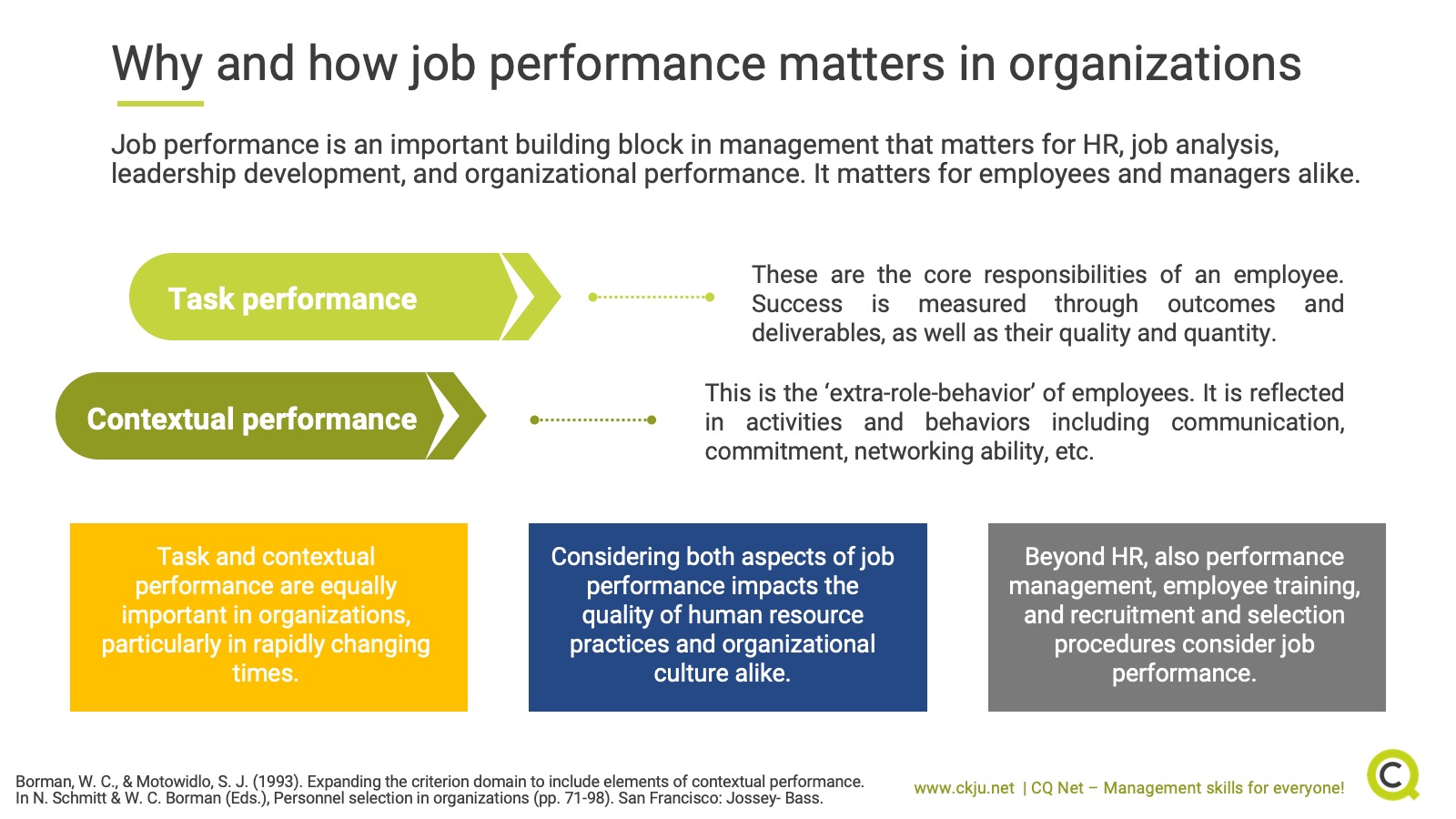- All Management Learning Resources
- Job performance

Executive summary
Job performance (sometimes also called work performance) is a widely used tool and metric in management, however organizations rarely address what it really is, which dimensions it includes, and in which areas of work it becomes important. This CQ Dossier describes the two major components of job performance - task and contextual performance - and their relevance to the workplace in various spheres. We discuss the available evidence of how organizations who incorporate contextual performance into hiring, appraisal and training can gain a competitive advantage and provide information on how the two components of job performance interplay in practice.
Contents
- Executive summary
- Job performance is an important building block in management
- Job performance consists of task performance and contextual performance
- Contextual performance: The ability of employees to contribute to the overall well-being of the organization
- The benefits of contextual performance: Improved organizational culture and climate
- Contextual performance is linked to organizational performance
- Personality and contextual performance: Selecting the right employees
- How and where does contextual performance matter in an organization?
- Key take-aways
- References and further reading
Job performance is an important building block in management
One of the main objectives of any working professional, whether it be a manager or an employee, is to deliver high performance on the job and to support your fellow peers, teams and coworkers to do the same. Consequently, the concept of job performance (sometimes also called work performance) is an important building block in management. However, even though the term job performance is a widely used tool in management, organizations rarely address what it really is, which dimensions it includes, and in which areas of organizational practice it becomes important.
Job performance consists of task performance and contextual performance
On a general level, job performance describes the contribution of an individual to the overall success of an organization. On a more specific and measurable level, job performance can be broken down into different factors. Depending on the framework you use, the factors vary (Koopmans et al. 2011). However, there is a broad consensus in the scientific community that job performance consists of two interplaying components.
According to Borman & Motowidlo (1993), job performance consists of two main factors:
- Task performance describes the core job responsibilities of an employee. It is also called "in-role prescribed behavior" (Koopmans et al. 2011) and is reflected in specific work outcomes and deliverables as well as their quality and quantity.
- Contextual performance goes beyond formal job responsiblities. Also referred to as "discretionary extra-role behavior" (Koopmans et al. 2011) contextual performance is reflected in activities such as coaching coworkers, strengthening social networks within an organization and going the extra mile for the organization.
Contextual performance: The ability of employees to contribute to the overall well-being of the organization
One of the most important functions of an organization is to ensure that employees are effective in performing their jobs. However, in recent years, contextual performance is viewed as an integral part of overall job performance. Now practitioners and researchers view job performance as moving beyond what is considered effective for performance on a task. In the VUCA world, with changes in the global market and increased competition, employees are now expected to go beyond what is expected in their job description.
Contextual performance captures this ability of employees to engage in activities that contribute to the overall well-being of the organization. This aspect of job performance is viewed as equally important as task performance. Examples of contextual performance include volunteering for additional work, being a good organizational citizen, cooperating with coworkers and additional discretionary behaviors (Borman & Motowidlo, 1993).
The benefits of contextual performance: Improved organizational culture and climate
Researchers and practitioners agree that job performance is multidimensional and consists of two main factors: task performance and contextual performance (Motowidlo & Schmit, 1999). Task performance is important because it relates to producing job-specific goods and services and requires employees to acquire and demonstrate core technical skills.
Although task performance is necessary, contextual performance boosts the organizational climate through strengthening social networks. When employees engage in contextual performance this contributes to the culture and climate of the organization. Contextual performance has the ability to transform the organization because employees volunteer for extra work, persist with enthusiasm and help and cooperate with others (Motowidlo & Schmit, 1999).
Contextual performance is linked to organizational performance
One of the main reasons to also include contextual performance as a measure of job performance is that it impacts the quality of human resource practices (Befort & Hattrup, 2003). Job performance is intrinsically linked to the goals and mission of the organization (Motowidlo & Schmit, 1999). Consequently, decisions concerning how to measure job performance and the relative weight assigned to task vs. contextual behaviors has important implications for decisions made regarding human resource practices (Befort & Hattrup, 2003).
Personality and contextual performance: Selecting the right employees
There is research to suggest that personality traits are more effective predictors of contextual performance rather than predictors of task performance (Borman & Motowidlo, 1997). Borman and colleagues demonstrated that the personality traits of conscientiousness and dependability correlate more highly with organizational citizenship behaviors than with task performance (Borman, Penner, Allen & Motowidlo, 2001). In comparison, general cognitive ability is more related to task performance (Arvey & Murphy, 1998).
There is also research showing that when organizations use job analysis, personality traits predict both task and contextual job performance (Jenkins & Griffith, 2004). One suggestion is to use narrow traits to predict contextual job performance rather than a reliance on global traits such as the Big Five personality factors (Jenkins & Griffith, 2004).
How and where does contextual performance matter in an organization?
Having introduced the concept of job performance and its two sub-dimensions, task performance and contextual performance, the questions arises how organizations can, should, and often already do make use of these two concepts.By understanding the interplay of these two dimensions, it becomes easier to understand how organizational practices work and how one's own behavior within it is crucial.
Human resource practices: Contextual performance plays a role in selection, assessment and performance appraisal
The importance of including contextual performance in human resource practices such as selection and assessment was demonstrated in a study by Murphy and Shiarella (1997). They demonstrated that the validity of selection procedures depended on the relative values placed on task and contextual performance. Including contextual performance in decision-making is also important for performance appraisal, which is an important human resource practice.
Managerial decision-making plays an important role in the performance appraisal function. Research has shown that supervisors differ in the relative weight they provide for the dimensions of task and contextual performance when deciding the overall contribution of the employee to the organization (Rotundo & Sackett, 2002). When managers place relative values on task and contextual performance behaviors this impacts decisions about promotions and other rewards.
Inclusion of contextual performance in assessment decisions can also impact the fairness of human resource practices. Research has shown that the relative importance that an organization places on task and contextual performance can influence adverse impact and the hiring of minorities (Hattrup, Rock & Scalia, 1997).
Job analysis often includes important task and contextual behavior
It is important for organizations to conduct a thorough job or organizational analysis to include important task and contextual behaviors that are job-relevant. One popular job analysis method, such as the Position Analysis Questionnaire, involves collecting ratings of the importance of job-relevant behaviors (McCormick, Jeannerette & Mecham, 1972).
Inclusion of these types of ratings has the potential to communicate those job-relevant behaviors that are valued within the organization. They impact hiring decisions and send a message on which behaviors are relevant to the organization in terms of daily behavior, behaviors that need to be trained, and behaviors that are rewarded through promotion or pay.
Leadership development: Contextual performance can be covered in management training initiatives
Research has shown that more experienced managers value contextual performance to a greater degree than less experienced managers (Befort, & Hattrup, 2003). Over time, managers gain a better appreciation of how task performance is related to the overall organizational context. Managers can learn to focus more on behaviors that are contribute to social connectedness and promote a positive work climate (Befort & Hattrup, 2003).
Organizations can implement management training initiatives that encourage less experienced managers to gain knowledge of how task and contextual performance are linked to the mission of the organization. These gains in knowledge can impact performance management measures such as appraisal ratings and managerial decision-making.
In conclusion, this CQ Dossier presents an argument for including both task and contextual performance for selection, performance management and training of employees. Inclusion of contextual performance provides organizations with a sustained competitive advantage because it is linked to the overall mission of the organization.
Key take-aways
- Job performance is a building block in management but is not clearly defined in many organizations
- Job performance consists of the two main factors task performance and contextual performance
- Task performance is reflected in specific work outcomes and deliverables as well as their quality and quantity
- Contextual performance occurs when employees go beyond what is expected
- Contextual performance contributes to the overall well-being of the organization
- Personality traits are related to contextual performance and can be used in hiring decision
- Experienced managers pay more attention to contextual performance than inexperienced managers
- Organizations can include contextual performance in job analysis efforts
Management skills newsletter
Join our monthly newsletter to receive management tips, tricks and insights directly into your inbox!
References and further reading
Arvey, R. D., & Murphy K.R. (1998). Performance evaluations in work settings. Annual Review of Psychology, 49, 141-168.
Befort, N. and Hattrup, K. (2003) Valuing Task and Contextual Performance: Experience, Job Roles, and Ratings of the Importance of Job Behaviors. Applied HRM Research, 8, 17-32.
Borman, W. C., & Motowidlo, S. J. (1993). Expanding the criterion domain to include elements of contextual performance. In N. Schmitt & W. C. Borman (Eds.), Personnel selection in organizations (pp. 71-98). San Francisco: Jossey- Bass.
Borman, W. C., Penner, L. A., Allen, T. D., & Motowidlo, S. J. (2001). Personality predictors of citizenship performance. International Journal of Selection and Assessment, 9, (1-2), 52-69.
Cichy, Ronald F.; Cha, JaeMin; Kim, SeungHyun (2009): The relationship between organizational commitment and contextual performance among private club leaders. In: International Journal of Hospitality Management 28 (1), S. 53–62.
Hattrup, K., Rock, J., & Scalia, C. (1997). The effects of varying conceptualizations of job performance on adverse impact, minority hiring, and predicted performance. Journal of Applied Psychology, 82, 656-664.
Koopmans, Linda; Bernaards, Claire M.; Hildebrandt, Vincent H.; Schaufeli, Wilmar B.; Vet Henrica, C. W. de; van der Beek, Allard J. (2011): Conceptual frameworks of individual work performance. A systematic review. In: Journal of occupational and environmental medicine 53 (8), S. 856–866.
McCormick, E. J., Jeanneret, P. R., & Mecham, R. C. (1972). A study of job characteristics and job dimensions based on the Position Analysis Questionnaire. Journal of Applied Psychology, 56, 347-368.
Motowidlo, S. J., & Schmit, M. J. (1999). Performance assessment in unique jobs. In D. R. Ilgen & E. D. Pulakos (Eds.), The changing nature of performance (pp. 56-86). San Francisco: Jossey-Bass.
Murphy, K. R., & Shiarella, A. H. (1997). Implications of the multidimensional nature of job performance for the validity of selection tests: Multivariate frameworks for studying test validity. Personnel Psychology, 50, 823- 854.
Rotundo, M., & Sackett, P. R. (2002). The relative importance of task, citizenship, and counterproductive performance to global ratings of job performance: A policy capturing approach. Journal of Applied Psychology, 87, 66-80.
About the Author







